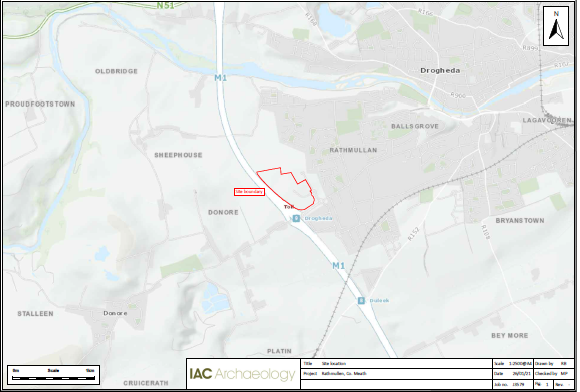2020:474 - Rathmullen, Drogheda, Meath
County: Meath
Site name: Rathmullen, Drogheda
Sites and Monuments Record No.: N/A
Licence number: 20E0082
Author: Marc Piera
Author/Organisation Address: c/o IAC Ltd, Unit G1 Network Enterprise Park, Kilcoole, Co. Wicklow
Site type: Neolithic/Bronze Age settlement
Period/Dating: —
ITM: E 706642m, N 774092m
Latitude, Longitude (decimal degrees): 53.705615, -6.384777
Archaeological excavation was carried out in Rathmullen in the south-western suburbs of Drogheda at a proposed data storage complex. The site is located on a flat greenfield overlooking the Boyne Valley. There are 13 recorded archaeological sites within 250m of the development area.
The excavation revealed a substantial number of features during topsoil removal, including an extended multi-period settlement complex dating from the Early Neolithic to modern era. The main phase of activity extends through multiple periods in prehistory from Early Neolithic to Bronze Age. There was very little evidence for the later Bronze Age and Iron Age identified at the site.
The features excavated included an early Neolithic rectangular house, which was constructed using interconnected slot trenches with additional structural post-holes. Carinated bowls were recovered from the post-hole fills and Grooved Ware pottery was recovered from larger pits.
A large causewayed enclosure was uncovered dating to the Neolithic with recuts dating to the Bronze Age. The causewayed enclosure measuring 80m long and 60m wide forming a near rectangular plan had two main periods of activity identified within, from Neolithic to Bronze Age. Two possible entrances were identified in the north-east and north-west corners. Scattered pits, hearths, a cluster of post-holes with a curvilinear gully and cobbled surface were all identified within the enclosure.
A timber circle structure c.7m in diameter and pits dating to the Neolithic were also identified, possibly forming a small hut structure, with a second similar cluster of post-holes identified a few metres to the north.
A c. 20m enclosure with an associated field system was noted, consisting of linear ditches sometimes unconnected, and with branches creating a large rectangular division of the land.
A c. 14m ring ditch and a second ring ditch was possibly associated with a Bronze age burial.
The remains of burnt mound (fulacht fiadh) activity were also recovered including large pits and troughs, organic fills, wattle and worked wood. The pits and troughs were filled with charcoal-rich clay and burnt stones.
Other linear ditches and gullies were identified across the site representing further field systems – with a clear concentration in the west, north, north-east and north-west of the site. It is not clear if these relate to separate farmsteads and may relate to the different key larger features across the rest of the site.
Post-excavation processing and subsequent further analysis are proposed for these archaeological features, artefacts and eco-factual samples. A programme of specialist analysis, including radiocarbon dating, is also envisaged. Samples will be analysed for environmental and economic or ritual indications.

